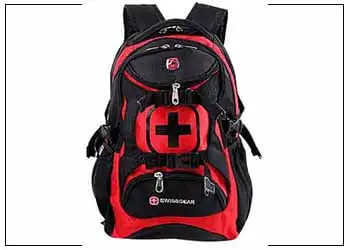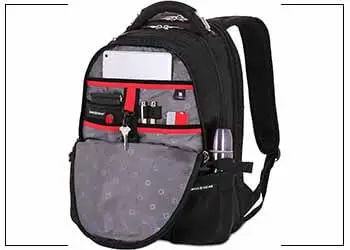Are you wondering, “Can you wash SwissGear backpack?” When it comes to maintaining the cleanliness and longevity of your SwissGear backpack, proper cleaning techniques are essential. SwissGear backpacks are renowned for their durability and functionality, but over time, they can accumulate dirt, stains, and odors. To address this, it’s natural to ask, are SwissGear backpacks washable? In the following lines, we will delve into the steps and precautions necessary to effectively clean your SwissGear backpack, ensuring it remains both a reliable companion and a stylish accessory.
Is Swissgear A Good Backpack?

Yes, SwissGear is generally considered a good backpack brand. SwissGear, also known as Wenger, is a Swiss company known for producing high-quality travel gear, including backpacks. They are well-regarded for several reasons:
- Durability: SwissGear backpacks are often praised for their durability. They are designed to withstand the rigors of travel and everyday use, which is especially important for people who need a reliable backpack for various activities.
- Functionality: SwissGear backpacks are known for their well-thought-out designs and functional features. They often come with multiple compartments, pockets, and organizers, making them suitable for keeping belongings organized and easily accessible.
- Comfort: Many SwissGear backpacks incorporate ergonomic designs, padded shoulder straps, and back panels for increased comfort, especially during extended periods of wear.
- Style: SwissGear offers a wide range of styles, from sleek and professional to casual and sporty, catering to different preferences and situations.
- Variety: The brand offers backpacks for different purposes, such as travel, commuting, school, outdoor adventures, and more. This variety allows individuals to choose a backpack that suits their specific needs.
- Reputation: SwissGear has built a reputation over the years as a reliable and trusted brand in the travel and backpack industry.
However, like any brand, individual experiences can vary based on personal preferences and specific product models. It’s always a good idea to read reviews, consider your intended use for the backpack, and carefully evaluate the features that matter most to you before making a purchase decision.
Are Swissgear Backpacks Washable?
SwissGear backpacks are typically not designed to be machine-washed. While they are made from durable materials, machine washing can potentially damage the fabric, zippers, and other components of the backpack. Instead of machine washing, it’s recommended to spot clean your SwissGear backpack using gentle methods to avoid compromising its quality and lifespan. If your backpack has a removable lining or smaller detachable parts, you might be able to hand wash those separately. Always check the care instructions provided by the manufacturer to ensure you’re using the appropriate cleaning methods for your specific SwissGear backpack model.
Related Articles:
- How to Wash North Face Backpack?
- Can You Wash Pottery Barn Backpacks?
- Can You Wash a North Face Backpack?
- How to Clean Lululemon Fanny Pack?
Can You Wash Swissgear Backpack?

SwissGear backpacks are not intended to be machine-washed, as the mechanical agitation and water pressure from washing machines can potentially damage the fabric, zippers, and structural integrity of the backpack. However, there are alternative methods you can employ to effectively clean your SwissGear backpack without compromising its quality. So, how to wash Swissgear backpacks? Let’s now learn about how to clean a Swissgear backpack.
Spot Cleaning:
For minor stains or dirt, spot cleaning is the safest approach. Use a mild detergent or a mixture of water and vinegar on a soft cloth or sponge. Gently scrub the affected area in a circular motion, then wipe with a clean damp cloth to remove any residue.
Hand Washing:
If your SwissGear backpack has removable parts like a detachable lining, you might be able to hand wash those separately. Fill a basin with lukewarm water and a small amount of mild detergent. Gently agitate the water and immerse the detachable parts. After a brief soak, use a soft brush or cloth to clean, then rinse thoroughly with clean water.
Interior Cleaning:
Empty the backpack completely and open all compartments. Use a handheld vacuum or lint roller to remove loose dirt and debris. Wipe down the interior with a damp cloth to remove any remaining dust.
Drying:
After cleaning, ensure the backpack is thoroughly dried. Hang it in a well-ventilated area, away from direct sunlight or heat sources. Avoid using a dryer, as the heat can affect the fabric and cause deformation.
Protection:
To prevent future stains and dirt buildup, consider using a fabric protector spray that is suitable for your backpack’s material. Apply it in a well-ventilated area and allow it to dry completely before using the backpack again.
Manufacturer’s Instructions:
Always refer to the care instructions provided by SwissGear for your specific backpack model. These guidelines will offer tailored advice on cleaning and maintenance.
Remember that different SwissGear backpack models may have variations in materials and construction, so it’s essential to treat your backpack with care. Regular maintenance and gentle cleaning methods will help keep your SwissGear backpack looking great and functioning properly for years to come.
Where Are Swissgear Backpacks Made?
Some people ask- Where are Swissgear backpacks manufactured?
Well, SwissGear backpacks are designed by the Swiss company Wenger, which is known for its high-quality travel and outdoor products. However, the manufacturing locations for SwissGear backpacks can vary. In the past, some of the production for Wenger products, including SwissGear backpacks, occurred in China. It’s important to note that manufacturing locations can change over time due to factors such as production costs, supply chain considerations, and other business factors. Therefore, it’s a good idea to refer to the specific product’s labeling or the manufacturer’s website for the most up-to-date information on where a particular SwissGear backpack is currently being produced.
Are All Swissgear Backpacks Waterproof?
Not all SwissGear backpacks are waterproof. While SwissGear offers a variety of backpack models, each with its own set of features and specifications, not all of them are designed to be fully waterproof. Some SwissGear backpacks may have water-resistant or water-repellent features, which means they can provide a certain degree of protection against light rain or moisture.
If waterproofing is a crucial requirement for you, it’s essential to carefully read the product descriptions and specifications provided by the manufacturer for the specific SwissGear backpack you’re interested in. In addition, look for features like sealed zippers, water-resistant materials, and a high level of water protection if that’s what you need. If the backpack is not explicitly labeled as waterproof, it’s a good idea to consider using additional waterproofing solutions or rain covers if you’ll be in situations where you might encounter heavy rain or exposure to water.
How to Wash a Swissgear Backpack?

So, how to clean Swissgear backpack?
Well, cleaning a SwissGear backpack requires careful attention to maintain its quality and longevity. Here’s a step-by-step guide on how to wash SwissGear backpacks properly:
Materials you’ll need:
- Mild detergent
- Lukewarm water
- Soft cloth or sponge
- Soft brush
- Clean, dry towels
Steps:
Step 1: Empty the Backpack:
Remove all items from the backpack’s compartments and pockets. Shake it gently to dislodge any loose dirt or debris.
Step 2: Spot Cleaning:
For minor stains, use a soft cloth or sponge dampened with a mixture of lukewarm water and mild detergent. Gently blot the stained area without rubbing excessively, as this can damage the fabric.
Step 3: Interior Cleaning:
Use a handheld vacuum or lint roller to remove loose dirt, crumbs, and debris from the interior compartments.
Step 4: Hand Washing Detachable Parts (if applicable):
If your backpack has removable parts like a detachable lining, fill a basin with lukewarm water and a small amount of mild detergent. Immerse the parts and gently agitate the water. Use a soft brush or cloth to clean the parts, then rinse thoroughly with clean water.
Step 5: Exterior Cleaning:
If the entire backpack needs cleaning, dilute a small amount of mild detergent in lukewarm water. Dip a soft cloth or sponge into the mixture and gently clean the exterior surface of the backpack. Pay attention to areas with visible stains or dirt.
Step 6: Rinsing:
Use a clean cloth or sponge dampened with clean water to rinse off the detergent residue from both the interior and exterior surfaces.
Step 7: Drying:
Gently pat the backpack with clean, dry towels to absorb excess moisture. Hang the backpack in a well-ventilated area, away from direct sunlight or heat sources. Ensure that zippers are left partially open to allow proper airflow. Avoid using a dryer, as the heat can damage the fabric and components.
Step 8: Final Touches:
Once the backpack is completely dry, inspect it for any remaining spots or stains. If necessary, repeat the spot cleaning process using the mild detergent solution.
Step 9: Optional Protection:
To help prevent future stains and dirt buildup, consider using a fabric protector spray that’s suitable for the material of your backpack. Apply it in a well-ventilated area according to the manufacturer’s instructions.
Step 10: Reassemble:
Once the backpack is clean and dry, reassemble any detachable parts and compartments.
Remember, it’s essential to refer to the care instructions provided by the manufacturer for your specific SwissGear backpack model. Different materials and designs may have varying cleaning recommendations. If you’re uncertain or if your backpack has significant stains or odors, consider consulting a professional cleaner who specializes in cleaning outdoor gear.
Can I Put My Swissgear Backpack In The Dryer?
It is generally not recommended to put your SwissGear backpack in the dryer. Dryers generate heat and mechanical agitation, both of which can potentially damage the fabric, zippers, straps, and other components of the backpack. High heat can cause materials to warp, shrink, or lose their structural integrity.
To properly care for your SwissGear backpack, follow these steps:
- After cleaning, gently pat the backpack with clean, dry towels to absorb excess moisture.
- Hang the backpack in a well-ventilated area, away from direct sunlight or heat sources, to air dry. Make sure that zippers are left partially open to allow proper airflow.
- Allow the backpack to dry completely before using or storing it.
If your backpack has detachable parts or linings, you might be able to hand wash or spot clean those separately. Always refer to the care instructions provided by the manufacturer for your specific SwissGear backpack model to ensure you’re following the best practices for cleaning and maintenance.
How Do I Tell Which Swissgear Backpack Model?
To determine the specific model of your SwissGear backpack, you can follow these steps:
- Check the Tags and Labels: Look for any tags, labels, or patches on the exterior or interior of the backpack. These tags often include information about the model name or number. The tag might be located on the inside of a pocket, on a strap, or near the zippers.
- Inspect the Packaging: If you still have the original packaging or box the backpack came in, it might have the model name or number printed on it.
- Check the Website or Documentation: Visit the official SwissGear or Wenger website and search for your backpack model. They often have product listings that provide detailed information about each model, including its name, features, and specifications.
- Compare to Online Images: Search for images of different SwissGear backpack models online and compare them to your backpack. Pay attention to specific design elements, pockets, zippers, and features that match your backpack.
- Contact Customer Support: If you’re having trouble identifying the model, you can contact the customer support of SwissGear or Wenger. Provide them with any relevant information, such as the appearance of the backpack and any available tags or labels. They might be able to help you determine the model based on your description.
- Visit a Retailer: If possible, visit a store that sells SwissGear backpacks. Compare your backpack with the models on display to find a match.
- Ask the Seller: If you purchased the backpack from a retailer, online store, or marketplace, you can reach out to the seller and inquire about the specific model of the backpack you bought.
Identifying the model of your SwissGear backpack can help you find additional information about its features, care instructions, and other relevant details.
How Many Liters Is The Swissgear Backpack 1900 Scansmart?
The SwissGear 1900 ScanSmart backpack typically has a capacity of around 31 liters. This capacity can vary slightly depending on how the backpack is expanded or adjusted. Keep in mind that the liter measurement provides an estimate of the volume the backpack can hold, helping you gauge its size and storage potential.
How Much Can A Swissgear Backpack Hold In Weight?
SwissGear backpacks, including the 1900 ScanSmart model, do not usually come with a specific weight capacity provided by the manufacturer. However, they are designed to comfortably hold the weight of typical items you might carry during your daily activities, such as laptops, books, clothing, and accessories.
While there’s no precise weight limit specified, it’s essential to use common sense when loading your backpack. Overloading any backpack, regardless of the brand, can strain the zippers, seams, and straps, potentially leading to damage over time. Additionally, carrying too much weight can be uncomfortable and strain your body.
As a general guideline, it’s recommended not to carry more than 10-15% of your body weight in your backpack. This will help you avoid unnecessary strain on your back and shoulders. If you need to carry heavy items frequently, consider using a backpack with padded shoulder straps and a padded back panel for better comfort and support.
If you have concerns about weight capacity for your specific SwissGear backpack, it’s a good idea to contact SwissGear customer support or refer to any documentation that came with your backpack for more information.
What Swissgear Backpack Should I Have?
The SwissGear backpack that’s right for you depends on your specific needs, preferences, and how you plan to use the backpack. SwissGear offers a wide range of backpacks designed for different purposes, so here are a few factors to consider when choosing the right one for you:
- Intended Use: Are you looking for a backpack for travel, school, work, outdoor activities, or everyday use? Different SwissGear models are tailored to specific activities, so choose one that aligns with your needs.
- Size: Consider how much space you need to carry your belongings comfortably. If you need to carry a laptop, books, and other items, make sure the backpack has appropriate compartments and dimensions.
- Laptop Compatibility: If you need to carry a laptop, ensure that the backpack has a padded laptop compartment that fits your laptop size securely.
- Features: Look for features that matter to you, such as multiple compartments, water resistance, padded shoulder straps, an ergonomic design, and organizational pockets.
- Style: SwissGear offers a variety of styles, from casual to professional, so choose a design that matches your personal style and the occasions you’ll be using the backpack for.
- Durability: Consider the materials used in the backpack’s construction. SwissGear is known for durability, but if you have specific durability requirements, prioritize those features.
- Comfort: If you’ll be wearing the backpack for extended periods, make sure it has comfortable padding on the straps and back panel.
- Budget: Determine your budget range and explore SwissGear backpacks within that range.
Based on these factors, you might want to explore the SwissGear 6752 ScanSmart Laptop Backpack, SwissGear 5698 Laptop Backpack, or SwissGear 5977 ScanSmart Laptop Backpack. You can research these models, read reviews, and consider how they align with your requirements to make an informed decision.
Frequently Asked Questions: Can You Wash Swissgear Backpack?
Q 1: Can you machine wash a SwissGear backpack?
A1: No, machine washing is not recommended for SwissGear backpacks as it can damage the fabric, zippers, and structure. Spot cleaning and gentle hand washing are better options.
Q 2: How do I spot clean my SwissGear backpack?
A 2: To spot clean, use a mixture of mild detergent and water on a soft cloth or sponge. Gently blot the stained area without rubbing excessively, then rinse with clean water.
Q 3: Can I wash the detachable parts separately?
A 3: Yes, if your backpack has detachable parts, you can hand wash them separately using a mild detergent and lukewarm water. Rinse thoroughly and let them air dry.
Q 4: Is it safe to dry my SwissGear backpack in a dryer?
A 4: No, using a dryer is not recommended as the heat and agitation can harm the backpack’s materials. Air drying in a well-ventilated area is the preferred method.
Q 5: Should I apply a fabric protector after washing my backpack?
A 5: Applying a fabric protector is optional but can help prevent future stains. Make sure to choose a protector suitable for your backpack’s material and follow the instructions carefully.
Final Words
In conclusion, washing a SwissGear backpack requires a cautious approach. While machine washing isn’t advised, spot cleaning with mild detergent and water, coupled with gentle hand washing for detachable parts, is preferable. Thorough drying in a well-ventilated space and optional fabric protector usage aid in maintaining its appearance. Adhere to manufacturer care instructions for specific guidance. Following these steps ensures your SwissGear backpack stays dependable and stylish for your daily use.
Read More Articles:
- Best Mom Backpacks
- How to Wear a Fanny Pack Crossbody
- Is A Fanny Pack Considered A Personal Item?
- Can You Pack Soda in Checked Luggage [know The 3-1-1 Rules]
- Will Cans Of Beer Explode In Checked Luggage
- What to Pack in Carry on Vs Checked Bag
- What Can I Pack In My Checked Luggage
- Best Travel Accessories for Women
- Best Travel Accessories for Men
- Best Travel Accessories for Seniors
- Kindergarten Backpack Size
- What to Put In Fanny Pack?
- How to Clean Lululemon Fanny Pack
- 101 Fanny Packs for Different Purposes
- Best Fanny Pack for Disney World

